I now have a copy of Edgar Waite and Herbert Hale’s “Review of the Lophobranchiate Fishes (Pipefishes and Seahorses) of South Australia”, thanks to the generosity of Robert Browne.
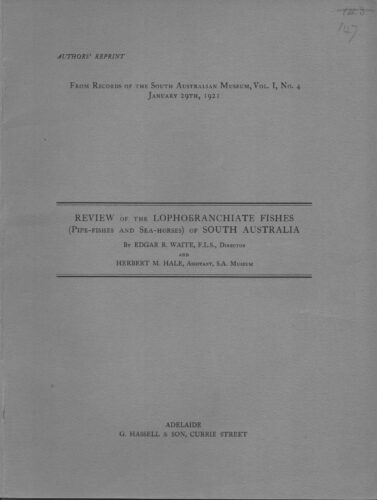
The review is an ‘Authors’ Reprint’ “From Records of the South Australian Museum, Vol.1, No.4, January 29th, 1921”.
Edgar R. Waite is listed as FLS, Director. Herbert M. Hale is listed as Assistant, SA Museum. Both were from the SA Museum, with Waite being the Director of the Museum. I’m assuming that the RLS refers to Waite having been made a Fellow of the Linnean Society in 1890.
The best part about Robert Browne’s gift of the book is that inside the pages is this personal letter from Sir Joseph Verco to Edgar Waite: –
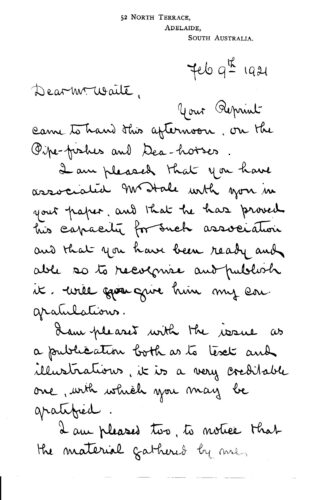
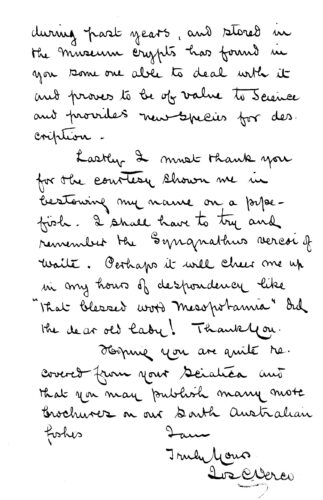
It reads: –
“Dear Mr Waite,
Your Reprint came to hand this afternoon, on the Pipe-fishes and Sea-horses.
I am pleased that you have associated Mr Hale with you in your paper, and that he has proved his capacity for such association and that you have been ready and able so to recognise and publish it. Will you give him my congratulations.(?)
I am pleased with the issue as a publication both as to text and illustrations, it is a very creditable one, with which you may be gratified.
I am pleased too, to notice that the material gathered by me during past years, and stored in the Museum crypts has found in you some one able to deal with it and proves to be of value to science and provides new species for description.
Lastly I must thank you for the courtesy shown me in bestowing my name on a pipe-fish. I shall have to try and remember the Syngnathus vercoi of Waite. Perhaps it will cheer me up in my hours of despondency like “that blessed word Mesopotamia” did the dear old lady!* Thank you.
Hoping you are quite recovered from your sciatica and that you may publish many more brochures on our South Australian fishes.
I am, Truly Yours
Jos C. Verco**”
* (An old saying it seems.)
** (Sir Joseph Verco had been knighted some 10 years earlier.)
(We have now passed the book and the letter to the SA Museum.)
Dr Robert Browne wrote about Sir Joseph Verco collecting pipefish specimens in his 2003 MLSSA Journal article titled “Pipefish, Museums, Marine Naturalists and Fish Conservation”. In that article, he stated, “These Short-snouted Seahorses were collected by Sir Joseph Verco in 1920. Sir Joseph Verco personally financed many marine expeditions and greatly contributed to the knowledge of marine biodiversity in South Australia.”
(The article goes on to state “In 1923 Mr. Edgar R. Waite published a catalogue of the fishes of South Australia.”)
I wrote about Joseph Verco myself in Scoresby Shepherd receives Verco Medal from the Royal Society of South Australia. My article stated “the Royal Society of South Australia was founded on 10th January 1853 (as the Adelaide Philosophical Society). The Society changed its name to the Royal Society of South Australia when her Majesty Queen Victoria granted the title “Royal” in 1880. In 1928, the Society struck a medal in honour of Sir Joseph Verco. The Verco Medal has since been awarded to members of the Royal Society for distinguished scientific investigations. (Sir Joseph Verco died in 1933.) According to the web page found at http://www.adelaide.edu.au/rssa/awards, “The (Verco) medal shall be awarded for distinguished scientific work published by a Fellow of the Royal Society of South Australia. It is the highest honour that the Society can bestow on one of its Fellows. Only those who have made a significant, outstanding contribution to their field(s) of study receive the award.
“The first Verco medal was awarded to Professor Walter Howchin in 1929. Medals have since been awarded to people such as J. B. Cleland, Sir Douglas Mawson and Reg Sprigg. Careful deliberation is said to go with each award of the medal, so the list of Verco Medallists is said to represent “a most revered, respected and outstanding collection of scientists.”
A biography for Sir Joseph Verco can be found at https://adb.anu.edu.au/biography/verco-sir-joseph-cooke-8914 . It describes how “Verco kept extensive diaries and ….. the manuscript of his sea travels was later edited by Bernard Cotton as “Combing the Southern Seas” (1935).
“The South Australian Naturalist (August 1933) included a bibliography of Verco’s work in malacology. Honorary conchologist at the museum from 1914, he methodically and succinctly described 169 new species and subspecies. A fish, a crustacean and a number of molluscs were named after him.”

Verco’s pipefish, Vanacampus vercoi
(Taken from “Pipefish, Museums, Marine Naturalists and Fish Conservation” by Dr Robert Browne)
Verco’s pipefish, Vanacampus vercoi was the pipefish named by Waite & Hale in 1921 (as Syngnathus vercoi).
A biography for Edgar Waite can be found at https://adb.anu.edu.au/biography/waite-edgar-ravenswood-8947 . Herbert Mathew Hale became the Director of the South Australian Museum from 1931 to 1960. I found that, born on 3rd June 1895, he went to Prince Alfred College and the University of Adelaide. He became assistant zoologist at the South Australian Museum in 1922.
He was appointed Director of the Museum In 1931. He, himself, was awarded the Verco Medal In 1946. He received an O.B.E. in 1954. He was President of the Royal Society of South Australia; a member of the Royal Zoological Society of South Australia; patron and life member of the South Australian Fish Protection and Anglers Association.
He died on 3rd September 1963.
We have two copies of “The Crustaceans of South Australia” by Herbert M. Hale in our library at the Port Environment Centre. Our Part I (mlssa No.1131)was donated by Dr Scoresby Shepherd, and it was published in 1927. Parts I & II are available together in a single book reprinted in 1976 (mlssa No.1003). Part II begins after page 201. Part II had first been published as a stand-alone book in 1929.
Part I (1921) tells us that Sir Joseph Verco wrote a handbook on molluscs and Edgar Waite wrote a handbook on fishes.*
* (As stated above, “Pipefish, Museums, Marine Naturalists and Fish Conservation” by Dr Robert Browne states, “In 1923 Mr Edgar Waite published a catalogue of fishes of South Australia.”Also, see my article titled The Work of Edgar Waite.)
It appears from Part II of “The Crustaceans of South Australia” that both Waite and Hale had a species of crustacean named after them. It appears from “The Marine and Freshwater Fishes of South Australia” handbook that a couple of fish species are named after Edgar Waite.
According to “Pipefish, Museums, Marine Naturalists and Fish Conservation” by Dr Robert Browne, these Short-head seahorses were collected by Sir Joseph Verco in 1920: –

Short-head seahorses collected by Sir Joseph Verco in 1920
(Taken from “Pipefish, Museums, Marine Naturalists and Fish Conservation” by Dr Robert Browne)
According to “Review of the Lophobranchiate Fishes (Pipefishes and Seahorses) of South Australia”, Sir Joseph Verco dredged a large 70 mm specimen of the Short-head seahorse, Hippocampus breviceps in the Gulf of St Vincent.
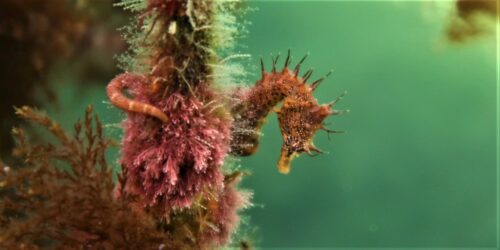
A Short-head seahorse, Hippocampus breviceps
(Taken by David Muirhead)
“Pipefish, Museums, Marine Naturalists and Fish Conservation” also states, “Sir Joseph Verco personally financed many marine expeditions and greatly contributed to the knowledge of marine biodiversity in South Australia.”
(My thanks go to Dr Robert Browne for re-introducing me to these fascinating details about Edgar Waite, Herbert Hale and Joseph Verco.)

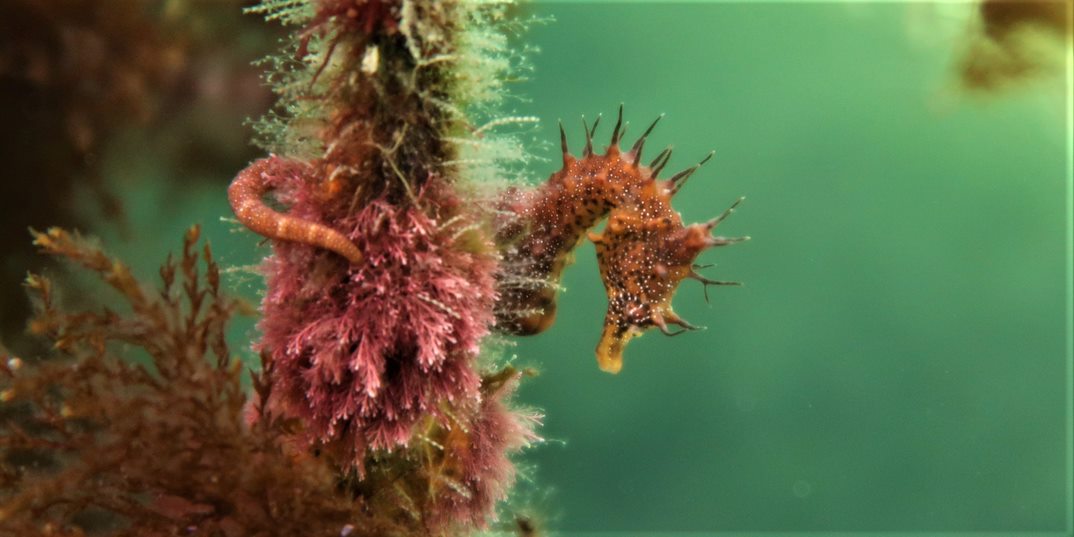
Interesting that the type specimen for Verco’s Pipefish was dredged in Spencer Gulf roughly a century ago. I don’t know of any records from Spencer Gulf since then.
A few from GSV, and some from Pelican Lagoon ki, and more recently a few from Yankalilla Bay, and lastly the unconfirmed sightings (no supporting photos apparently, but the pers com came from a highly experienced ichthyologist) from Encounter Bay .
So we can all anticipate encountering Verco’s Pipefish in Spencer Gulf, sooner or later.
Also interesting is that the type specimen of Deepbody Pipefish is ( or are) also from Spencer Gulf, via dredging.
But that’s less surprising, given that species seems to associate closely with mangroves.
(My first encounter was at Port Broughton, FWIW).